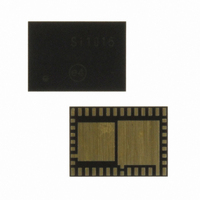SI1005-C-GM Silicon Laboratories Inc, SI1005-C-GM Datasheet - Page 201

SI1005-C-GM
Manufacturer Part Number
SI1005-C-GM
Description
IC TXRX MCU + EZRADIOPRO
Manufacturer
Silicon Laboratories Inc
Specifications of SI1005-C-GM
Package / Case
42-QFN
Frequency
240MHz ~ 960MHz
Data Rate - Maximum
256kbps
Modulation Or Protocol
FSK, GFSK, OOK
Applications
General Purpose
Power - Output
13dBm
Sensitivity
-121dBm
Voltage - Supply
0.9 V ~ 1.8 V
Current - Receiving
18.5mA
Current - Transmitting
30mA
Data Interface
PCB, Surface Mount
Memory Size
32kB Flash, 4kB RAM
Antenna Connector
PCB, Surface Mount
Number Of Receivers
1
Number Of Transmitters
1
Wireless Frequency
240 MHz to 960 MHz
Interface Type
UART, SMBus, SPI, PCA
Output Power
13 dBm
Operating Supply Voltage
0.9 V to 3.6 V
Maximum Operating Temperature
+ 85 C
Mounting Style
SMD/SMT
Maximum Supply Current
4.1 mA
Minimum Operating Temperature
- 40 C
Modulation
FSK, GFSK, OOK
Protocol Supported
C2, SMBus
Core
8051
Program Memory Type
Flash
Program Memory Size
32 KB
Data Ram Size
4352 B
Supply Current (max)
4.1 mA
Lead Free Status / RoHS Status
Lead free / RoHS Compliant
Operating Temperature
-
Lead Free Status / Rohs Status
Lead free / RoHS Compliant
Other names
336-1875-5
Available stocks
Company
Part Number
Manufacturer
Quantity
Price
Company:
Part Number:
SI1005-C-GM
Manufacturer:
Silicon Labs
Quantity:
135
- Current page: 201 of 376
- Download datasheet (3Mb)
20.3. SmaRTClock Timer and Alarm Function
The SmaRTClock timer is a 32-bit counter that, when running (RTC0TR = 1), is incremented every
SmaRTClock oscillator cycle. The timer has an alarm function that can be set to generate an interrupt,
wake the device from a low power mode, or reset the device at a specific time. See Section “12. Interrupt
Handler” on page 129, Section “14. Power Management” on page 151, and Section “18. Reset Sources”
on page 175 for more information.
The SmaRTClock timer includes an Auto Reset feature, which automatically resets the timer to zero one
SmaRTClock cycle after the alarm signal is deasserted. When using Auto Reset, the Alarm match value
should always be set to 2 counts less than the desired match value. Auto Reset can be enabled by writing
a 1 to ALRM (RTC0CN.2).
20.3.1. Setting and Reading the SmaRTClock Timer Value
The 32-bit SmaRTClock timer can be set or read using the six CAPTUREn internal registers. Note that the
timer does not need to be stopped before reading or setting its value. The following steps can be used to
set the timer value:
1. Write the desired 32-bit set value to the CAPTUREn registers.
2. Write 1 to RTC0SET. This will transfer the contents of the CAPTUREn registers to the SmaRTClock
3. Operation is complete when RTC0SET is cleared to 0 by hardware.
The following steps can be used to read the current timer value:
1. Write 1 to RTC0CAP. This will transfer the contents of the timer to the CAPTUREn registers.
2. Poll RTC0CAP until it is cleared to 0 by hardware.
3. A snapshot of the timer value can be read from the CAPTUREn registers
20.3.2. Setting a SmaRTClock Alarm
The SmaRTClock alarm function compares the 32-bit value of SmaRTClock Timer to the value of the
ALARMn registers. An alarm event is triggered if the SmaRTClock timer is equal to the ALARMn registers.
If Auto Reset is enabled, the 32-bit timer will be cleared to zero one SmaRTClock cycle after the alarm
event.
The SmaRTClock alarm event can be configured to reset the MCU, wake it up from a low power mode, or
generate an interrupt. See Section “12. Interrupt Handler” on page 129, Section “14. Power Management”
on page 151, and Section “18. Reset Sources” on page 175 for more information.
The following steps can be used to set up a SmaRTClock Alarm:
1. Disable SmaRTClock Alarm Events (RTC0AEN = 0).
2. Set the ALARMn registers to the desired value.
3. Enable SmaRTClock Alarm Events (RTC0AEN = 1).
Notes:
timer.
The ALRM bit, which is used as the SmaRTClock Alarm Event flag, is cleared by disabling
SmaRTClock Alarm Events (RTC0AEN = 0).
If AutoReset is disabled, disabling (RTC0AEN = 0) then Re-enabling Alarm Events (RTC0AEN = 1)
after a SmaRTClock Alarm without modifying ALARMn registers will automatically schedule the next
alarm after 2^32 SmaRTClock cycles (approximately 36 hours using a 32.768 kHz crystal).
The SmaRTClock Alarm Event flag will remain asserted for a maximum of one SmaRTClock cycle. See
Section “14. Power Management” on page 151 for information on how to capture a SmaRTClock Alarm
event using a flag which is not automatically cleared by hardware.
Rev. 1.0
Si1000/1/2/3/4/5
201
Related parts for SI1005-C-GM
Image
Part Number
Description
Manufacturer
Datasheet
Request
R
Part Number:
Description:
SMD/C°/SINGLE-ENDED OUTPUT SILICON OSCILLATOR
Manufacturer:
Silicon Laboratories Inc
Part Number:
Description:
Manufacturer:
Silicon Laboratories Inc
Datasheet:
Part Number:
Description:
N/A N/A/SI4010 AES KEYFOB DEMO WITH LCD RX
Manufacturer:
Silicon Laboratories Inc
Datasheet:
Part Number:
Description:
N/A N/A/SI4010 SIMPLIFIED KEY FOB DEMO WITH LED RX
Manufacturer:
Silicon Laboratories Inc
Datasheet:
Part Number:
Description:
N/A/-40 TO 85 OC/EZLINK MODULE; F930/4432 HIGH BAND (REV E/B1)
Manufacturer:
Silicon Laboratories Inc
Part Number:
Description:
EZLink Module; F930/4432 Low Band (rev e/B1)
Manufacturer:
Silicon Laboratories Inc
Part Number:
Description:
I°/4460 10 DBM RADIO TEST CARD 434 MHZ
Manufacturer:
Silicon Laboratories Inc
Part Number:
Description:
I°/4461 14 DBM RADIO TEST CARD 868 MHZ
Manufacturer:
Silicon Laboratories Inc
Part Number:
Description:
I°/4463 20 DBM RFSWITCH RADIO TEST CARD 460 MHZ
Manufacturer:
Silicon Laboratories Inc
Part Number:
Description:
I°/4463 20 DBM RADIO TEST CARD 868 MHZ
Manufacturer:
Silicon Laboratories Inc
Part Number:
Description:
I°/4463 27 DBM RADIO TEST CARD 868 MHZ
Manufacturer:
Silicon Laboratories Inc
Part Number:
Description:
I°/4463 SKYWORKS 30 DBM RADIO TEST CARD 915 MHZ
Manufacturer:
Silicon Laboratories Inc
Part Number:
Description:
N/A N/A/-40 TO 85 OC/4463 RFMD 30 DBM RADIO TEST CARD 915 MHZ
Manufacturer:
Silicon Laboratories Inc
Part Number:
Description:
I°/4463 20 DBM RADIO TEST CARD 169 MHZ
Manufacturer:
Silicon Laboratories Inc











